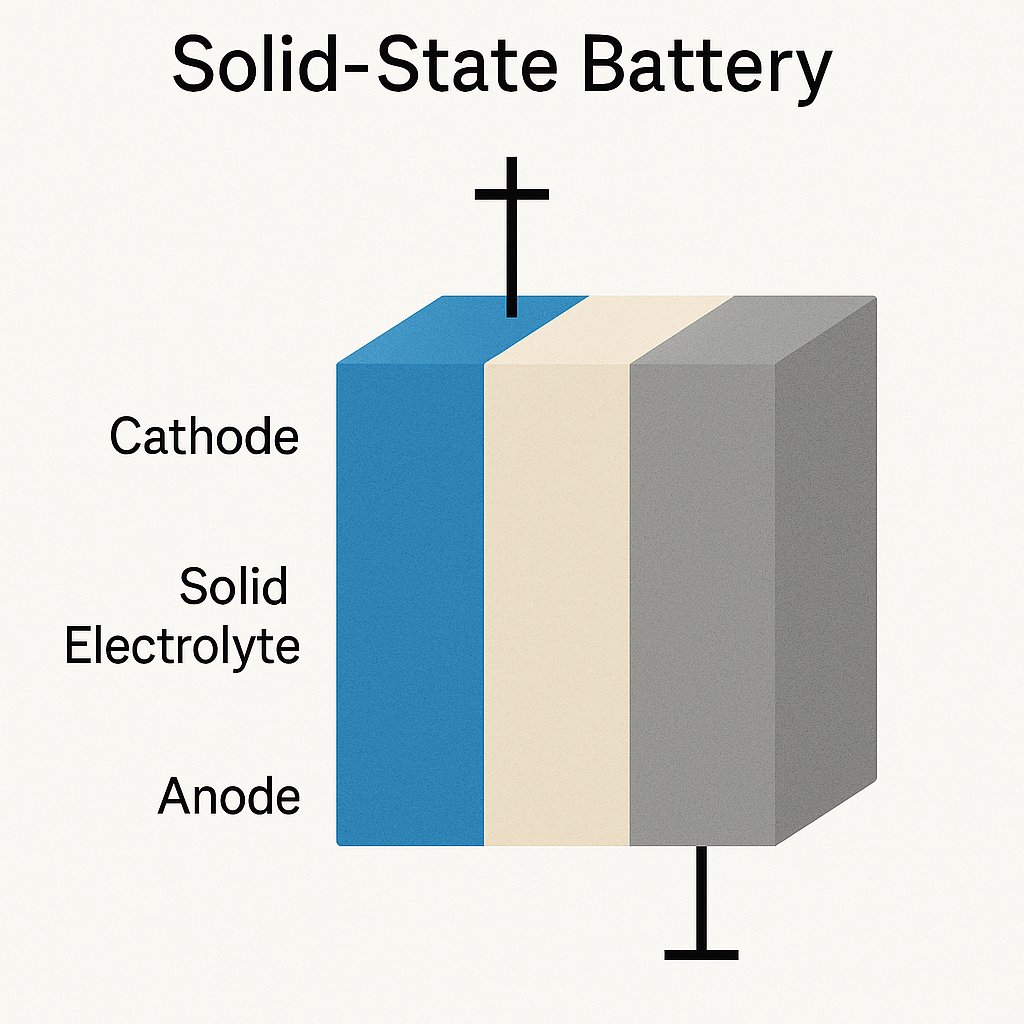
🧭May 20, 2025, Post 3: Solid-State Batteries: The Future of Safe and Efficient Energy Storage | High Quality Mains Essay | Prelims MCQs
Solid-State Batteries: The Future of Safe and Efficient Energy Storage

NATIONAL HERO
🗓️ Post Date: May 20, 2025
📘 Thematic Focus: GS3 – Science & Technology / Energy
🌱 Intro Whisper
In the silent chambers of the battery, a quiet war brews — between power and precision, between longevity and failure. Solid-state batteries may well be the calm after the storm, promising a safer, denser, and longer-lasting future.
⚡ Key Highlights
- What Are Solid-State Batteries (SSBs)?
SSBs use a solid electrolyte instead of a liquid one, enhancing safety and energy density. Their compact design removes the need for bulky safety measures used in lithium-ion batteries. - Main Advantage:
Improved thermal stability, longer life cycle, and non-flammability make them ideal for next-gen tech like electric vehicles (EVs). - Key Challenge – Dendrite Growth:
During charging, lithium ions accumulate and form needle-like dendrites, which can pierce the solid electrolyte and cause short circuits. - Operando Microscopy Insight:
Scientists now use operando scanning electron microscopy to observe real-time dendrite formation at the anode–electrolyte interface, identifying early-stage voids and crack propagation. - Mechanical Fatigue in Lithium Anodes:
Similar to metal fatigue, repeated charge-discharge cycles cause cracks and structural defects in lithium, even under low-stress conditions. - Future Research Focus:
– Understanding lithium’s stress-strain behaviour
– Enhancing battery modeling to predict failure
– Optimizing cycling rates and temperature thresholds - Applications Already in Place:
Used in pacemakers, smartwatches, and pilot EV projects. Large-scale deployment for EVs and renewable grids is in progress.
🧪 Concept Explainer – What is Solid-State Physics?
Solid-state physics is a branch of physics that studies the properties of solid materials—including crystals, metals, semiconductors, and insulators. It examines how electrons, atoms, and ions behave within solid structures.
🔹 It forms the theoretical basis for technologies such as semiconductors, lasers, solar cells, and batteries.
🔹 In SSBs, solid-state physics helps scientists understand ion conduction, mechanical strain, and phase transitions inside the battery’s material layers.
🗺️ GS Paper Mapping
- GS Paper 3:
– Science and Technology – Developments and Applications
– Environmental and Energy Security
– Indigenisation of Technology and Developing New Technology
– Achievements of Indian Scientists & Institutions
🌌 A Thought Spark — by IAS Monk
“Power doesn’t just reside in energy — it hides in the silence between charges. Solid-state dreams are sculpted not in volts, but in voids, in the invisible mechanics of matter’s patience.”
High Quality Mains Essay For Practice :
Word Limit 1000-1200
“Charging the Future: The Promise and Perils of Solid-State Battery Technology”
“Science is nothing but the refinement of everyday thinking.” – Albert Einstein
In the great arc of human advancement, energy has always been the axis of civilization. From fire to fossil fuels, steam engines to solar cells, every leap in progress is anchored in how we store, distribute, and harness energy. As the 21st century pivots toward clean energy and electric mobility, one innovation stands out like a beacon: Solid-State Batteries (SSBs). Promising a radical improvement in safety, density, and durability, SSBs appear poised to define the future. Yet, like the lithium ions they carry, this future must travel through a labyrinth of challenges—scientific, economic, and ethical.
The Heart of the Revolution: What Makes Solid-State Batteries Different?
At the core of a battery lies its electrolyte—the medium that allows ions to travel between the cathode and anode. Conventional lithium-ion batteries use a liquid electrolyte, which is efficient but flammable and prone to thermal runaway. Solid-State Batteries, as the name suggests, replace this with a solid electrolyte, which could be ceramic, polymer, or sulfide-based.
This change has transformative implications:
- Increased energy density, enabling longer-lasting devices and EVs.
- Improved safety, reducing the risk of fire or explosion.
- Compact design, eliminating the need for heavy separators or cooling systems.
- Faster charging, with reduced chances of overheating.
If these batteries reach mass production and cost-efficiency, they could reshape industries—from smartphones to space travel, from smart grids to pacemakers.
Cracks Beneath the Surface: The Challenge of Dendrites and Mechanical Fatigue
However, the transition is not smooth. One of the most persistent problems is the growth of lithium dendrites—needle-like structures that form on the anode during repeated charging. These dendrites can pierce the solid electrolyte and cause internal short circuits, leading to battery failure or even thermal hazards.
This is where solid mechanics meets electrochemistry. Just like a metal rod develops cracks under repetitive bending, lithium metal in an SSB undergoes fatigue due to cyclic charge-discharge cycles. These tiny cracks accumulate over time and act as nucleation points for dendrites. Researchers are now treating batteries as mechanical structures, using models from material science to study how stress, void formation, and interfacial instability evolve in real-time.
A cutting-edge tool aiding this exploration is operando scanning electron microscopy, which allows scientists to observe battery components as they operate. Such insights are critical to redesigning electrodes that can absorb mechanical stress without failing.
Global Power Play: Strategic Stakes in Solid-State Innovation
The race to commercialize SSBs is not just scientific—it’s geopolitical. The countries that master battery technologies will shape the future of electric vehicles (EVs), defense applications, and grid-scale storage.
- Japan and South Korea, home to companies like Toyota and Samsung, lead in ceramic electrolyte research.
- China dominates the supply chain for lithium, cobalt, and rare earths, giving it leverage in battery manufacturing.
- The United States is investing through public-private partnerships, including the U.S. Department of Energy’s Battery Innovation Center.
India, while late to the lithium-ion game, has a strategic opportunity to leapfrog into solid-state tech. With its burgeoning EV market, PLI schemes for battery storage, and ambitious targets under the National Electric Mobility Mission, India must not miss this inflection point.
The Ethical Undercurrent: Mining, Waste, and the Cost of Clean Energy
Every technological leap comes with an ethical footprint. Batteries are no exception.
- Lithium mining, especially from salt flats in Latin America or hard rock in Australia, often results in groundwater depletion, land degradation, and local displacement.
- Cobalt mining in the Democratic Republic of Congo has been linked with child labor and unsafe conditions.
- Battery disposal and recycling remain weak spots, with limited infrastructure for end-of-life processing.
Solid-state batteries, with their longer lifespans and greater recyclability potential, offer hope. But unless sustainability is built into their design and deployment, they may solve one crisis while creating another.
The Road Ahead: Modelling, Material Science, and Multidisciplinary Innovation
The road to scalable solid-state battery production runs through materials engineering, data modeling, and thermal physics. Future breakthroughs will likely come from:
- Better materials like lithium-sulfur or garnet-based ceramics with higher ionic conductivity.
- Improved interface design that prevents dendrite penetration and distributes stress more evenly.
- Smart modeling that uses AI and simulation to predict battery degradation before it occurs.
Additionally, manufacturing must move from laboratory settings to gigafactories, reducing costs and increasing consistency.
Applications and the Promise of Decentralized Energy
Already, SSBs are powering implantable medical devices like pacemakers and are being tested in high-end electric vehicles. Their potential for stationary energy storage can revolutionize microgrids, making villages and cities resilient to blackouts.
Imagine a future where your home stores solar energy in safe, compact SSB units, or where an EV can be charged in 5 minutes and driven for 1,000 kilometers without risk. That’s not science fiction—it’s a scientifically constrained reality waiting to be unlocked.
Conclusion: In the Stillness of Solids, a Charged Destiny
In many ways, solid-state batteries are metaphors for the world they aim to empower—dense, promising, yet fragile. Like the silent lithium ion moving through a crystalline maze, our journey toward energy sustainability is full of invisible complexities.
The next leap in battery innovation is not just about volts and watts. It is about patience, foresight, and balance—a recognition that true power lies not in brute force, but in elegant precision.
“The future belongs to those who prepare for it today,” said Malcolm X.
And the future, quietly humming beneath a ceramic shell, may just be solid-state.
Target IAS-26: Daily MCQs :
📌 Prelims Practice MCQs
Topic:
MCQ 1 – Type 1: How many of the above statements are correct?
Consider the following statements about Solid-State Batteries (SSBs):
1. Solid-state batteries use liquid electrolytes for faster ion movement.
2. Dendrite formation in SSBs can cause internal short circuits and battery failure
3. SSBs offer better thermal stability and energy density compared to conventional lithium-ion batteries.
4. Operando microscopy helps researchers observe battery degradation in real-time.
How many of the above statements are correct?
A) Only two
B) Only three
C) All four
D) Only one
🌀 Didn’t get it? Click here (▸) for the Correct Answer & Explanation
✅ Correct Answer: B) Only three
🧠 Explanation:
Correct Answer: B) Only three
1.❌ False – SSBs use solid, not liquid electrolytes.
2.✅ True – Dendrite growth is a major challenge, causing potential short circuits.
3.✅ True – They offer better thermal stability and energy density.
4.✅ True – Operando microscopy enables real-time observation of battery behavior.
MCQ 2 – Type 2: Two-Statement Evaluation
Consider the following statements regarding recent research in solid-state battery development:
1. Cyclic loading on lithium anodes can result in mechanical fatigue, leading to cracks.
2. Researchers have proposed increasing the liquid content to counter dendrite growth in SSBs.
Which of the above statements is/are correct?
A) Only 1 is correct
B) Only 2 is correct
C) Both are correct
D) Neither is correct
🌀 Didn’t get it? Click here (▸) for the Correct Answer & Explanation
✅ Correct Answer: C) Both are correct
🧠 Explanation:
A) Only 1 is correct
1.✅ True – Repetitive stress causes fatigue and cracks, leading to failure.
2. ❌ False – Increasing liquid content contradicts the solid-state principle; researchers aim to improve solid interfaces, not add liquid.
MCQ 3 – Type 3: Which of the following are correct?
Which of the following statements are correct regarding solid-state battery technology?
1. SSBs are already widely used in electric vehicles worldwide.
2. They eliminate the need for bulky thermal safety systems.
3. Their solid electrolyte helps reduce the risk of fire and thermal runaway.
4. Solid-state batteries are more efficient due to higher energy density.
Select the correct code:
A) 2, 3, and 4 only
B) 1, 2, and 3 only
C) 1, 3, and 4 only
D) 2 and 4 only
🌀 Didn’t get it? Click here (▸) for the Correct Answer & Explanation
✅ Correct Answer: A) 2, 3, and 4 only
🧠 Explanation:
Correct Answer: A) 2, 3, and 4 only
1. ❌ False – SSBs are still in the pilot stage and not widely adopted in EVs yet.
2. ✅ True – Their stable design removes the need for bulky safety mechanisms.
3. ✅ True – Solid electrolytes are less flammable and safer.
4. ✅ True – They offer better energy density than traditional lithium-ion batteries.
MCQ 4 – Type 4: Direct Factual Question
What is the primary cause of failure in Solid-State Batteries during charge cycles?
A) Excessive heating of liquid electrolytes
B) Loss of electron flow in cathodes
C) Dendrite formation at the anode
D) Battery expansion due to gas release
🌀 Didn’t get it? Click here (▸) for the Correct Answer & Explanation.
✅ Correct Answer: C) Dendrite formation at the anode
🧠 Explanation:
C) Dendrite formation at the anode
• Dendrites are needle-like structures formed during lithium deposition that can penetrate the solid electrolyte, causing internal short circuits.

















